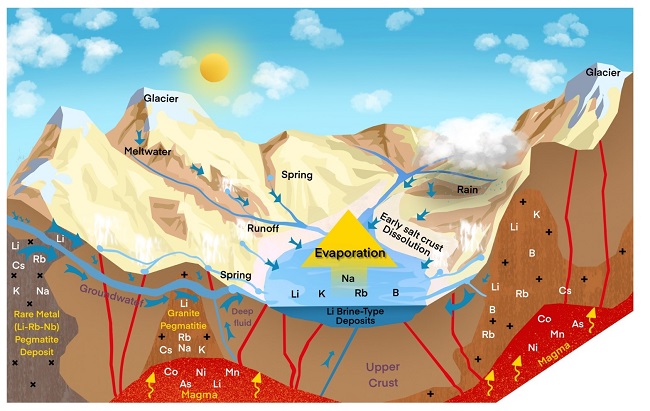Tracing the Sources and Hydrological Processes of Salt Lakes on Qinghai-Tibetan Plateau by Stable Li and B Isotopes
The Qinghai-Tibetan Plateau is known for its abundance of salt lakes is rich in lithium and boron resources. The production volume of salt lakes plays a crucial role in the supply of lithium and boron in China. Nevertheless, the issues of element sources, migration, and mineralization mechanisms of the brine lithium-boron deposits are not well understood, which extremely limits the exploration, development, and prospecting prediction of brine deposits.
Prof. HE Maoyong from the Institute of Earth Environment, Chinese Academy of Sciences, collaborated with the Qinghai Salt Lake Institute, Chang'an University, Taiyuan University of Technology, etc., have systematically sampled the salt lakes in the Qaidam Basin and Tibet on the Qinghai Tibetan Plateau since 2012, and conducted research on non-traditional stable lithium and boron isotopes, making important progress at this stage.
They investigated the hydrochemistry, Li and B isotope characteristics of surface brine lake water and recharge river samples of Lakko Co. and found concentrations of elements such as Rb, and Cu were relatively high and exhibited a strong correlation with Li. Ions composition and content ratios indicated the deep origin of Li and B.
Through the study of the "source-sink" system in Lakko Co Salt Lake, Bangor Salt Lake and Kushui Lake adjacent to the pegmatite type Li deposit in Tibet, they found that in the supergene geochemical system, the bedrock rich in lithium and granite pegmatite lithium deposits with different "source-sink" systems had made significant contributions to the richness of boron and lithium in salt lakes through the processes of surface weathering, adsorption, end member mixing, etc. More importantly, regardless of spatial scales of multiple "source-sink", geothermal fluids contribute to the lithium-rich salt lakes at multiple "source-sink" spatial scales, but the amount of their contribution still needs to be further evaluated.
In addition, they propose a mineralization conceptual model for a small-scale "source-sink" salt lake system rich in Li and B, suggesting that the enrichment of Li and B in typical salt lakes in inter-mountain basins is a joint result of the coupling of multiple factors such as regional lithology, tectonic background, climate, and hydrological conditions.
This work was published in Journal of Hydrology on Jan. 23.

Fig.1 Metallogenic model of the small-scale "source-sink" lithium-rich salt lake system (Image by LI, et al )
Contact: BAI Jie, Institute of Earth Environment, Chinese Academy of Sciences, Xi'an, China. Email: baijie@ieecas.cn
 © 2015 Institute of Earth Environment,CAS
© 2015 Institute of Earth Environment,CAS Address:No. 97 Yanxiang Road, Xi'an 710061, Shaanxi, China

 Location :
Location :